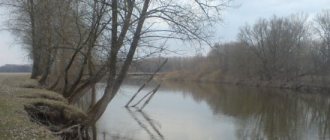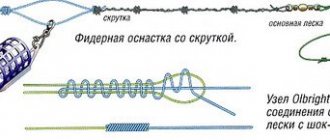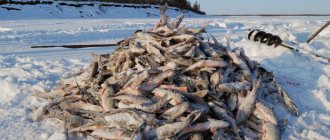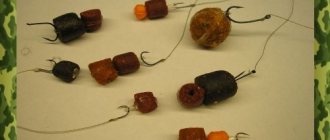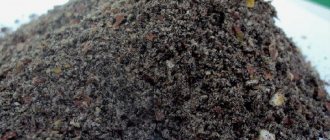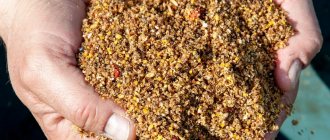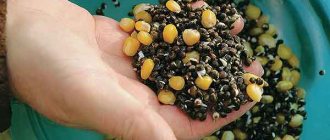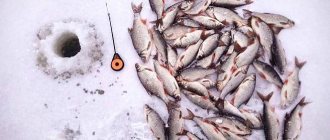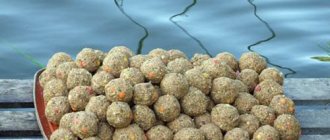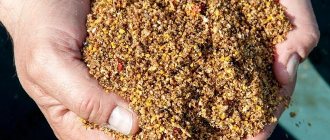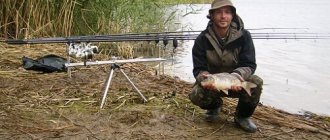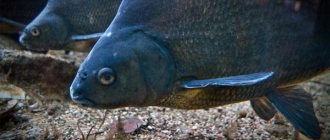How to make your own bait for cold water (autumn, winter). Natural baits in groundbait. What should not be added. What filler is used? What fraction should the bait be for cold water? What flavorings are added?
It is no secret that the success of fishing in late autumn and winter largely depends on bait, which in cold water must have certain properties. Of course, there are now countless ready-made mixtures on sale, but despite the intense advertising by respected fishing experts and the prices for these wonderful baits, they are not always actually mixtures that actually work. Often, even the inscription on the packaging indicating winter bait does not correspond to the contents, when the “winter bait” smells of fragrant biscuits and fruits.
The same story happens with fishing line, when designations and various pictures in the form of penguins and snowflakes only disguise and mislead fishermen, since the packaging often contains ordinary summer fishing line. The lies and cynical deception inherent in the trade in food and clothing also affected the sale of fishing goods. At the same time, gear and accessories for summer and winter fishing are quite expensive goods. Therefore, as before, fishermen try to make the necessary things with their own hands to the best of their ability. This also applies to bait.
Difference from summer
Before you stop preparing winter bait, you should find out what is the difference between it and traditional summer bait? And this difference exists, and not in just one parameter. First of all, it is necessary to note the fine-grained composition of winter bait, where all the ingredients are ground to a dust state. This composition of winter bait only stimulates the fish’s appetite, without saturating it. This small bait creates a noticeable food cloud in the water, attracting fish from afar, as far as visibility in the under-ice kingdom allows. Smells also serve to attract fish. And for this purpose, various low-calorie fillers are used, in particular, with copra, finely ground bran, grain husks, Belgian coconut and other components containing low-calorie substances.
Features of winter fishing in open water
By nature, this type of fishing is no different from summer fishing, although the level of comfort is completely different, and the fish are not as active as in summer. Despite this, in winter you can also count on catching large specimens. In this case, much depends on the availability of food in the reservoir.
What gear is used
Winter fishing in open water involves using the same gear as in summer. For example:
- Fly fishing rod.
- Match fishing rod.
- Spinning.
- Plug fishing rod.
- Feeder.
- Onboard gear.
- Winter fishing rod.
Selection of gear for winter fishing. Recommended:
- Choose a rod up to 6-7 meters in length. It is advisable that the fishing rod be light, since your hands will quickly get tired and cold.
- The rod must be durable, since there is a possibility of catching large specimens.
- The thickness of the fishing line must be at least 0.15 mm.
- The float should be heavier than for summer. The movements of the bait should be smooth, without sudden movements.
As a rule, a spinning rod with the following characteristics is selected for winter fishing:
- Choice of spinners. Oval-shaped baits made of brass or cupronickel, 1-1.5 mm thick, are more suitable. The tee is chosen wider than the spinner by a couple of millimeters, with an attractive red plumage.
- Choosing a balancer. Lures Nos. 2-9 are the most catchy during this period. It is desirable that there be elements that additionally attract fish - these are beads or flies that have a brighter color.
- Choice of live bait. Crucian carp is suitable as live bait, as it is the most tenacious fish.
Fishing from a boat requires the following gear:
- In the case when fishing is carried out from a boat, both the summer and winter options may be suitable. In this case, the rod tip should be used to detect bites. When fishing at depths of up to 6 meters, a meter rod is suitable, and for fishing at shallower depths, you should take a rod up to 1.5 meters long.
- Choosing a jig. For winter fishing, a jig like the “devil”, up to 20-25 mm long, is suitable. If the bite is sluggish, then it is better to take smaller baits.
- Hooks. For example, it is advisable to have tees with bright elements, such as bright beads or cambrics.
Groundbait and bait
The choice of bait and bait depends on the nature of the reservoir and the type of fish that is intended to be caught. Therefore, there are a number of recommendations, such as:
- Baits such as bloodworms, worms or maggots are always in demand, both in summer and winter. If fishing is carried out in winter, measures should be taken to ensure that the bait does not freeze. Therefore, it is necessary to have a special device where the bait always remains alive and active.
- It’s better to prepare bait at home, otherwise it’s not at all comfortable to prepare it near a pond, especially when it’s frosty outside. The bait should also be stored in a special container so that it does not freeze.
- In winter, it is better to give up various bite activators, such as flavors, and rely on natural scents.
The subtleties of winter fishing in open water
Fishing in winter on open water comes with some features that you should be aware of. For example:
- The fishing rod should be light and mobile, since you have to hold it in your hands for a lot of time.
- To prevent the line from getting tangled, the sinkers are placed in the following sequence: the heaviest ones first, and then the lighter pellets. Basically, pellet type weights are used.
- Retrieving the bait should be smooth, without jerking.
- In winter you should dress as warmly as possible.
- When fishing from the shore, the length of the rod is selected depending on the fishing conditions.
- In cold weather, the coil and guide rings may freeze.
The smell of bait
There is another important factor that influences the attractiveness of winter bait. It's the smell. If in the summer, fish from the carp family are offered mixtures with bright fruity and biscuit odors, then in the winter, such aromatic baits with a strong odor can, instead of attracting fish to a fishing spot on an autumn river or to a winter hole, on the contrary, scare them away with such aggressive odorous substances . It is better to add various syrups for cold water to the bait, which, without having any strong odors, nevertheless attract autumn fish to the fishing point. Such syrups are: “Hemp in Fish”, “Smoked Crayfish”, “Salmon”, “Red Caviar”.
Flavors with the smell of bloodworms, worms and maggots can also be effective in the cold season. Well, and, of course, introducing natural baits into the groundbait would be a good solution. It is clear that worms can only be added to bait if they are chopped into pieces, otherwise they will scatter at the bottom. Bloodworms and maggots are also not very persistent, but it makes no sense to “halve” them, otherwise these larvae will leak out.
Catching strong fish in cold water
With expert advice, you can successfully catch your first carp in cold water.
Biting time: use warm time of day
Although in spring the daytime air temperature is often pleasant, the water generally remains very cold. Compared to air, water bodies warm up more slowly. Accordingly, the metabolism of carp occurs slowly. The best catch prospects are immediately after lunch, when water temperatures reach their maximum. This usually happens two or three hours after the highest point of the solstice. The fish then become noticeably more active and begin to feed. Since small bodies of water, such as ponds, warm up faster, this effect on them is somewhat more pronounced.
Marco Mariani, writer for Blinker magazine
Feeding: without saturation
It is also worth feeding carp in the spring. Repeated pre-feeding on the eve of fishing helps the fish get used to the place and visit it regularly. To achieve the habituation effect, you must always throw in the food at the same time. In the spring I use bait that does not saturate the carp too quickly. It keeps them hungry and increases the chances that the carp will take the bait with the hook. My favorite baits are seeds such as corn, tiger nuts, hemp, and mini pellets. Hemp helps carp remain hungry and actively seek food.
Gregor Bradler, editor-in-chief of Karpfen magazine
Bottom bait: protein-rich food
My spring carp bait mix consists of 1.5kg Sensas Extra Grosse, 1.5kg Sensas Etang, 500g ground toasted poppy seeds and 200g toasted coconut. I moisten the mixture and pass it through an 8mm sieve. Then I add 1 liter of maggots, half a liter of caster and 1 kg of fish pellets with a diameter of 4 mm. A can of canned corn completes the mixture. First, I throw in 10 balls of bait flavored with casters and corn. Then follow five balls, into which I add a little spice concentrate and a few drops of pepper oil. When the fish arrive at the fishing spot and begin to bite, I feed them every minute.
Jean-Jacques Chaumet, complementary feeding expert
Removal from water: carefully insert into landing net
I usually catch spring carp with a match fishing rod. Its parabolic structure helps to quickly tire the carp. The structure of the Bolognese fishing rod allows you to better move carp away from obstacles. To prevent hooked fish from breaking the line, the reel brake must be set to the optimal force. It is especially difficult to pull fish out of the water. When the carp approaches the landing net, they often make a strong jerk. This is a particularly dangerous moment, since it can break the upper part of a steeply set rod.
Preparing bait for cold water (autumn, winter)
Of course, you can prepare winter bait yourself without such exotics as Belgian coconuts and other foreign ingredients. This component can be replaced with dry semolina and bran. And the main component of the bait can be made into pea porridge in the form of puree. You can then add slightly undercooked millet porridge, dry semolina, barley and corn grits to the pea puree.
To make it more crumbly and create an attractive food cloud in the water column, you can add breadcrumbs and milk powder to the bait. The addition of fried finely ground seeds serves the same purpose. They are an active component that, when washed away, will create movement of the bait in the water column. All these ingredients will not be able to saturate the fish, but can only attract it with the smell, appearance of the food cloud and movement. This is why you need to add undercooked millet to the bait. In the water in which the porridge is to be cooked, you need to add just a little granulated sugar and salt, just a little. These components are also attractive to fish. Salt, by the way, is also found in many artificial baits made from edible rubber.
Add syrups to the finished mixture and the cold water bait is ready.
Wobbler for pike
Recipes for autumn bait for bream
The general requirements for the bait mixture are as follows: it must be viscous and dense enough to prevent its movement by water flows. In the summer, the viscosity of the bait can be ensured by adding rolled oat flakes to the porridge. This component is not used in the autumn mixture; the porridge must be replaced with clay. The bait should not crumble upon contact with the surface of the water; it should quickly move to the bottom and crumble in this place. When using clay, animal components will be washed away by the current and attract fish.
A good catch of carp fish in the autumn can be obtained by using high-quality bait. The mixture should contain food with a high protein content - these are components of animal origin. It is not recommended to use fragrances with an intense odor here; they will only scare away approaching prey. Fish bait can be bought at any specialized store, but some people make such mixtures themselves. Below are some popular recipes.
Despite the animal composition, the following components should be present in the fall bait:
- three volume parts of crackers;
- one part of well-chopped sunflower cake;
- dried and ground clay.
The amount of animal components is taken in terms of 5 kilograms of the finished mixture. For this volume you need to take 200 grams of bloodworms and the same amount of maggots. To enhance the effect and give the mixture a special smell, chopped worms are used.
Photo 3. Poor in plant composition, but rich in animal composition - autumn bait.
A simpler way to make bait mixture is to mix millet porridge with clay. Mosquito larvae, chopped worms and maggots are added to this basic composition. As we have already said, the amount of soil increases with decreasing temperature. If there is cold weather, the mixture may contain only clay and crushed dung worms.
When fishing with a float rod, small balls of bait are thrown pointwise, preferably in one place, which will reduce the area of the feeding area. For other gear, it is practiced to supply bait along with the feeder.
What kind of fish is caught in winter?
If there is no ice on a reservoir, and it is fed by some warm source, then the same fish can be caught on it in winter as in summer. For example:
- Pike.
- Perch.
- Roach.
- Crucian carp.
- Bream.
- Bleak.
- Rudd.
- Carp.
Fishing for pike in winter in open water
Predatory fish, such as pike, are the most sought after trophy at any time of the year, including winter.
Where to look for pike in winter
In the month of December, during the first two weeks, the pike is in its favorite places, which include:
- Various types of shelters, both natural and artificial.
- Places where smaller rivers flow into larger ones.
- Edges where minor changes in relief are observed.
- Bays and harbors.
- Thickets of aquatic vegetation, such as reeds or reeds.
Using bait in winter
With the onset of real cold weather, the pike moves to depth. If there is ice on the pond, then the following gear will be useful:
- Zherlitsy.
- Spoons for vertical trolling.
- Balancers.
- Vibrating tails.
- Jig baits.
- Fishing with live bait.
Fishing for pike in December using a spinning rod
Fishing with a spinning rod in winter, when it is cold outside and the angler is wearing several layers of clothing, is not just fishing, but a separate sport. If you take into account that there is also snow, you can imagine how much effort a spinner spends to catch the desired trophy. After all, a fisherman does not stand in one place, but moves over considerable distances. To spend a minimum of effort and energy, it is better to use a number of tips. These include:
- To prevent ice from building up, it is better to use an anti-icing spray.
- Fishing from ice depends on the fishing depth and ice thickness: if the ice thickness is about 10 cm, then fish can be caught from a depth of about 6 meters, and with an ice thickness of 20 cm - from a depth of about 4 meters and with ice thickness 25 cm fish are caught from a depth of half a meter.
- It is better to go fishing in stable weather conditions, without pressure changes.
- When fishing from ice, the first cast of the spoon should not be accompanied by sudden movements. When the spoon reaches the bottom, only then can a sharp movement be made, after which the spoon rises up to a certain height. When the bait reaches the bottom, you should form a pause lasting up to 5 seconds.
- If fishing is carried out in open water, then it is better to arm yourself with a rod up to 3 meters long with a fast action. Such a rod will help you make long and accurate casts, while the tackle will be quite sensitive. Lures, twisters and foam fish are suitable as bait. If the bite is sluggish, then it is better to fish with live bait.
Catching roach in open water in winter
Roach, as a rule, behaves quite actively, both in summer and winter. And yet, you should adhere to certain subtleties of catching this fish in winter. For example:
- In winter, roach is caught mainly using bloodworms or maggots.
- You can feed the fish with the same ingredients as in summer, only without adding flavorings, since in cold water odors do not spread as actively as in summer.
- For fishing, you should choose days with stable weather and constant pressure. It's better if it's a cloudy day.
- It is advisable not to make unnecessary movements on the shore, since the water is more transparent in winter and the fish can notice movement on the shore.
- When carrying out preparatory operations, you should not make too much noise.
- Wiring should be done in different layers of water, since the fish can be on any horizon.
- If bites are observed, then this place should be fed additionally.
- If a fish disappears, you need to immediately throw the bait into the water. Thus, you can resume biting again.
